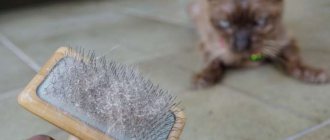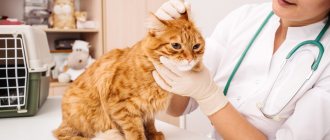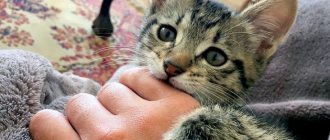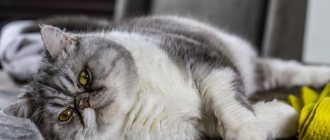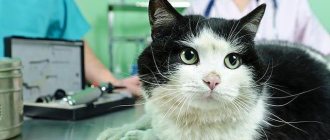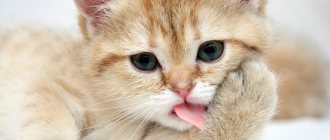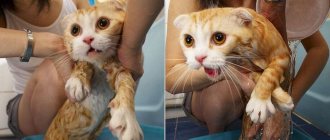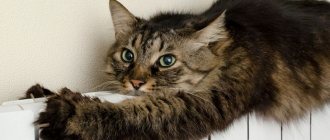Absolutely every cat, regardless of breed, age and living conditions, tries to keep itself clean. Therefore, every day the pet is carefully licked several times - its fur coat, body, each paw in turn, tail and genitals. But sometimes the completely natural process of grooming an animal takes on the character of an obsession, and the cat constantly licks, and the reasons for this behavior are not always clear. This needs to be sorted out.
Cats usually lick and groom themselves after sleeping or eating. And this is normal, since cats are very clean by nature. But it happens that a cat begins to lick a specific place longer and longer. And for each situation there are reasons.
The cat licks and itches, but there are no fleas
Even if no fleas were visible during a visual inspection of the cat, this does not mean that there are none at all. Very often, small black grains are visible among the fur, very similar to trash - these are nits. And sometimes, small transparent bubbles – lice eggs – are attached to the pet’s hairs.
However, not only fleas can cause a cat to lick and itch. This can also be done by other pathological microorganisms, such as scabies mites. In this case, the pet will have visible skin damage on the ears, ankles and elbows.
Other possible reasons for your pet licking and scratching include:
- Allergies to food, plant pollen, hygiene products, or insect bites (the cat scratches its face, scratches its ears, intensively licks and bites its paws). In this case, the veterinarian will recommend a diet to test for any specific component of the food that is causing adverse effects.
- Fungal and bacterial inflammation. A set of certain fungi and bacteria are found on the skin and mucous membranes of both humans and their pets. Being in a normal state, these microorganisms do not harm. But if the immune system weakens, their number quickly increases, and inflammatory processes begin. Fungal inflammation causes severe itching.
- Otitis is an ear infection that causes itching. A cat with otitis media itches and displays the following signs: it scratches its face, furiously rubs its ears, and shakes its head; swelling and redness of the ears appears, and purulent discharge from the ears.
- Skin diseases (pyodermitis, notoedrosis, demodicosis, etc.) arise as a result of skin pathologies. The rashes that appear on the skin cause severe itching and discomfort. Scabies can also be accompanied by external signs such as baldness.
Inflammation of the anal glands and postoperative sutures
On the sides of the anus there are paired formations - paraanal glands, which are necessary for marking territory, attracting partners for mating, and scaring away large predators. In case of digestive disorders, injuries, pregnancy, the excretory ducts become clogged, the secretion remains inside, and paraproctitis develops. The pet smells bad, he licks the sore spot and rubs it on the floor.
Elderly pets living in high-rise apartments, castrati and obese cats are predisposed. The solution to the problem is cleaning the anal glands, rinsing them or removing them. Prevention consists of feeding with professional nutrition of at least premium class.
If the course of wound healing is unfavorable after castration, suppuration develops or copious exudate is released. The cat begins to lick the seams, which can provoke an inflammatory process. The optimal solution is to treat the defect with an aerosol antiseptic wound healing agent to create a gauze-free dressing. In some cases, a cervical collar is put on the cat.
Cat licks after sterilization
Cats always take special care to lick any slightest damage to the skin, be it a sore, wound or suppuration. And sterilization is a full-fledged operation, so the pet will definitely try to lick this wound, even through a blanket. As the postoperative scar heals, it begins to itch very much, and you want to scratch it furiously. All this can be disastrous for the cat and lead to serious complications. Therefore, it is recommended that the cat be given a surgical collar for ten days after surgery.
How to call a veterinarian at home?
What questions will need to be answered? In order to call a veterinarian, you need to:
- Call the operator at the numbers specified in the Contacts section;
- Tell what happened to the animal;
- Provide the address (street, house, front door, floor) where the veterinarian will arrive;
- Specify the date and time of the doctor’s arrival
Call a veterinarian at home and he will definitely help you. At home, as they say, walls can be healed.
Similar symptoms:
What to do if your cat is constantly licking
Having noticed that the cat has begun to lick and scratch almost all the time, and this is no longer simple self-care, the owner first of all needs to examine his pet for fleas. If fleas are not found, you need to remember whether one cat food was changed to another, whether a new shampoo was used, and whether any plant bloomed in the house.
A cat that scratches itself until it bleeds, licks itself and shakes its head frequently is most likely suffering from one of the skin diseases. You need to take her to the vet immediately. It will not be possible to make a diagnosis on your own, since scratching can be accompanied by many pathologies.
At the veterinary clinic, scrapings will be taken from the cat and microscopic and bacteriological studies will be carried out on their basis. They will allow you to identify fungal spores (if microsporia and trichophytosis occur) or mites (if demodicosis, sarcoptic mange or notoedrosis are present).
If the veterinarian suspects hormonal disorders, he may refer you for a blood test and, based on the results, will conduct an examination of the cat’s endocrine system.
Constipation
Regular brushing prevents blockage of the intestines with lumps of hair swallowed when licking.
When defecation is difficult or absent, the cat begins to lick the anus, believing that this will help it.
Stool retention occurs for the following reasons:
- Unbalanced diet. If you give your cat only animal ingredients that do not contain dietary fiber, peristalsis stops. In such cases, switching to professional food of at least premium class, which contains fiber, helps. With a natural type of feeding, the situation is corrected by the inclusion of vegetables in the diet. If the desired result is not achieved, use oil laxatives or seek veterinary help.
- Blockage with hairballs. Develops in long-haired pets with natural feeding. They use Malt paste, if it does not help, go to the clinic.
- Intussusception: One part of the intestine enters another due to an unsuccessful jump or push.
- Blockage by helminths - eliminated in the presence of a veterinarian with the help of anthelmintics, since intoxication with waste products of parasites or intestinal rupture cannot be ruled out.
- Postoperative constipation: contact the surgeon and follow his orders.
- Neoplasms are identified by chance during a clinical examination. Your veterinarian may suggest symptomatic treatment, surgery, or euthanasia.
Be sure to read:
Third eyelid in a cat: causes, treatment at home, when no intervention is required
Preventing constipation consists of rational nutrition with natural or professional food.
Long-haired pets are regularly combed, using Malt paste or switched to super premium food, which includes components that prevent the formation of trichobezoars - soft stones from hairballs soaked in the intestinal contents.
To prevent high infestation, quarterly deworming is carried out.
Treatment
The veterinarian prescribes treatment not that concerns the itching, but that concerns the very cause of the disease. The course of treatment consists of taking medications and includes both local and internal medications. Depending on the cause of the disease, the veterinarian may prescribe antibiotics, antihistamines (to eliminate allergies), and antifungals.
If scabies and redness of the skin are caused by an allergy to food or hygiene products, their use will have to be stopped and the food replaced with another, in general, to get rid of all allergens.
Causes
In males, excessive licking of the perineum can be caused by inflammation of the preputial sac (the fold of skin of the foreskin that forms the space between the skin and the head of the penis). Preputial lubricant is found in the folds of skin that surround the penis. In a healthy cat, a small amount of whitish-yellow smegma may accumulate around the preputial opening; this is considered normal. In case of inflammation, this fluid may consist of blood, urine or pus. Here are some reasons:
- Diseases of the foreskin, including neoplasms (cancer), injury, foreign body, or balanoposthitis (inflammation of the foreskin of the penis)
- Urethral diseases: neoplasia, trauma or stone formation
- Bladder diseases: infections, stones, inflammation or tumors
- Prostate diseases such as prostatitis (infection or inflammation of the prostate gland), neoplasms, hyperplasia (enlargement), cysts or abscess
- Coagulopathy (bleeding), including thrombocytopenia (decreased platelet count) and rat poison poisoning
- Urinary incontinence due to displacement of the ureter or improper functioning of the sphincter that controls the release of urine
In females, abnormal vaginal discharge may lead to excessive licking of the perineum. Vaginal discharge – can be a normal part of your cycle or during the postpartum period, sometimes lasting 6 to 8 weeks. Causes of excessive abnormal discharge include:
- Urinary tract infections (uterine infection)
- Neoplasia (cancer) of the genitourinary system
- Vaginitis (inflammation of the vagina) or inflammation anywhere in the genitourinary system
- Coagulation (clotting), disorders associated with rat poison or low platelet counts
- Trauma or presence of a foreign body in the urogenital tract
- Urinary incontinence, ureteral displacement, or problems with the sphincter that controls urine output
- Retained placenta or fetal death
The presence of genital discharge suggests the presence of an underlying disease, ranging from mild to severe, life-threatening for the pet.
Preventing itching
Prevention of itching plays a very important role, so compliance with its basic measures will prevent the development of pathological processes accompanied by unpleasant symptoms.
Carry out hygiene procedures as often as possible - wet cleaning, washing cat bowls and washing their bedding.
Regularly clean your pet's ears and treat them with special medications.
Provide your pet with a balanced diet and try to prevent it from coming into contact with other animals.
Now everything has become clear why a cat can lick and itch. To solve the problem with a cat licking, you will have to be patient and time. And it doesn’t matter whether it’s a psychological or physiological reason. By providing your pet with enough attention and proper care, you can count on the fact that after some time his life will return to normal and his fur will be restored.
Symptoms
- Excessive licking of the perineum
- Visual changes
- Discharge
- Swelling in the genital area
When your cat is licking its tail and you, not knowing what to do, are looking for advice on this topic on the Internet on forums, we recommend not to self-medicate or experiment on your beloved cat. The fact is that there are many reasons for licking under the tail of an animal, and the consequences of your experiment may disappoint you and your family.
Dermatitis in cats
Itching and pain of the skin can be caused by dermatitis. This disease is caused by an immune disorder and the activation of opportunistic microorganisms on the animal's skin. Dermatitis is always accompanied by inflammation of the epidermis.
With moderate inflammation, the animal becomes restless, itching, and the cat constantly licks its fur. Suspecting the disease at this stage is quite problematic.
In most cases, dermatitis is accompanied by visible symptoms - severe peeling of the skin, the formation of rashes, wounds and erosions. The rashes are most often localized on the pet's face, near the ears and on the neck.
Treatment is carried out using external agents, but only after identifying the pathogen.
We invite you to familiarize yourself with: Fur seal, marine mammals, photos, species
Is it dangerous?
Frequent licking of a pet's fur should alert the owner. The following symptoms indicate the development of overgrooming:
- the appearance of bald patches in different parts of the body;
- areas with sparse hairs that often break;
- deterioration of the coat condition;
- signs of allergies;
- scratches, ulcers and other wounds on the skin of a cat that take a long time to heal;
- lethargy, apathy and reluctance to eat.
If the problem is neglected, it threatens to affect more areas on the animal’s body.
If you do not carry out treatment in time and do not get rid of the problem in which the cat licks the fur down to the skin, then there is a high probability of multiple bald spots appearing, which will deteriorate the appearance of the pet. When overgrooming, there is a risk of infection in the wounds, as a result of which an acute inflammatory process progresses in the deep structures of the epidermis. When a cat not only injures the skin through frequent licking, but also chews it out in pieces, necrotic lesions appear. Overgrooming is a common cause of disrupted natural hair replacement process.
Diagnostics
If your cat is itching a lot, but there are no fleas, you should immediately look for the cause. First of all, you should visit a veterinary clinic, because there are many factors that cause such behavior in your pet, and only a specialist will make an accurate diagnosis.
- The veterinarian will definitely take a detailed history of the disease - find out the age of the cat, its lifestyle, find out when the peak of the reaction occurs and the intensity of the itching, whether anti-flea treatment and deworming were carried out, how much time has passed since the last vaccination.
- Examine areas of irritation to determine the type of skin reaction - identifying alopenia, plaques, sores, granulomas. They especially carefully check the ear canal and the space between the fingers - the most common places for allergies to manifest.
- To identify a skin disease or dermatitis, the veterinarian will conduct tests: by combing, taking scrapings from the skin for microscopic examination, an adhesive tape test (for lice, lice), examination of earwax to detect ear mites, and cytological examination of smears.
Also read the article about why a cat can scratch itself until it hurts.
